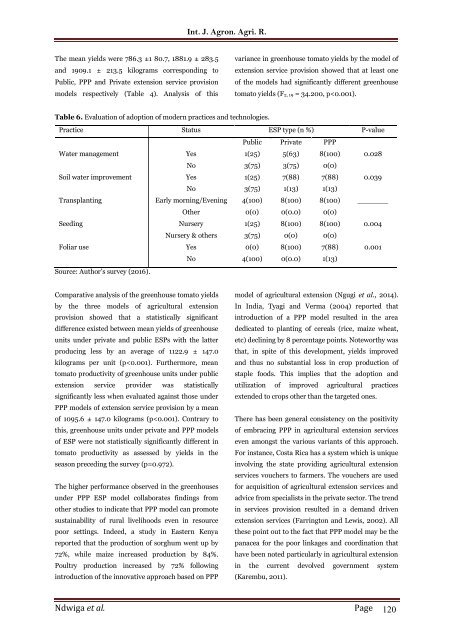Assessing the role of public-private partnerships in the provision of agricultural extension services: ˴the case of greenhouse tomato farming in Samburu County, Kenya
Abstract Agricultural extension services provide farmers with important information, such as patterns in crop prices, new seeds varieties, management practices and training in new technologies. Provision of such information enables farmers to optimize the utilization of the scarce resources at their disposal. In the past, a number of agricultural extension models have been employed with varying levels of success in developing countries. This study sought to document the effectiveness of the public-private partnership (PPP) model in provision of agricultural extension services in Samburu, a remote rural area of Kenya. Comparison of greenhouse tomato mean yields and standard deviations obtained by public private partnership was made using ANOVA and Chi square. Honest Significant Differences tests were also derived and used in this analysis The mean± standard error (se) yields per greenhouse varied significantly by the various models assessed (786.3±180.7, 1881.9±283.5 and 1909.1±213.5 kilograms corresponding to the public, PPP and private models respectively (p<0.001). Tomato productivity in greenhouse units under public model were statistically significantly less when evaluated against those under PPP model (mean± se difference of 1095.6±147.0 kilograms (p<0.001). Yields in greenhouse units under private and PPP models were not significantly different (p=0.972). These variations mirrored the levels of adoption of modern agricultural practices and technologies in the three models of extension services provision. The current study adds to the accumulating evidence that PPP may be the panacea to the ailing public agricultural extension services. Creating effective operational linkages between extension service providers and, perhaps, other key stakeholders such as input suppliers, credit and research institutions has the potential to improve the delivery of agricultural extension services to farming households in resource poor settings.
Abstract
Agricultural extension services provide farmers with important information, such as patterns in crop prices, new seeds varieties, management practices and training in new technologies. Provision of such information enables farmers to optimize the utilization of the scarce resources at their disposal. In the past, a number of agricultural extension models have been employed with varying levels of success in developing countries. This study sought to document the effectiveness of the public-private partnership (PPP) model in provision of agricultural extension services in Samburu, a remote rural area of Kenya. Comparison of greenhouse tomato mean yields and standard deviations obtained by public private partnership was made using ANOVA and Chi square. Honest Significant Differences tests were also derived and used in this analysis The mean± standard error (se) yields per greenhouse
varied significantly by the various models assessed (786.3±180.7, 1881.9±283.5 and 1909.1±213.5 kilograms corresponding to the public, PPP and private models respectively (p<0.001). Tomato productivity in greenhouse
units under public model were statistically significantly less when evaluated against those under PPP model (mean± se difference of 1095.6±147.0 kilograms (p<0.001). Yields in greenhouse units under private and PPP models were not significantly different (p=0.972). These variations mirrored the levels of adoption of modern agricultural practices and technologies in the three models of extension services provision. The current study adds to the accumulating evidence that PPP may be the panacea to the ailing public agricultural extension services. Creating effective operational linkages between extension service providers and, perhaps, other key stakeholders such as input suppliers, credit and research institutions has the potential to improve the delivery of agricultural extension services to farming households in resource poor settings.
You also want an ePaper? Increase the reach of your titles
YUMPU automatically turns print PDFs into web optimized ePapers that Google loves.
Int. J. Agron. Agri. R.<br />
The mean yields were 786.3 ±1 80.7, 1881.9 ± 283.5<br />
and 1909.1 ± 213.5 kilograms correspond<strong>in</strong>g to<br />
Public, PPP and Private <strong>extension</strong> service <strong>provision</strong><br />
models respectively (Table 4). Analysis <strong>of</strong> this<br />
variance <strong>in</strong> <strong>greenhouse</strong> <strong>tomato</strong> yields by <strong>the</strong> model <strong>of</strong><br />
<strong>extension</strong> service <strong>provision</strong> showed that at least one<br />
<strong>of</strong> <strong>the</strong> models had significantly different <strong>greenhouse</strong><br />
<strong>tomato</strong> yields (F2, 19 = 34.200, p





![Review on: impact of seed rates and method of sowing on yield and yield related traits of Teff [Eragrostis teff (Zucc.) Trotter] | IJAAR @yumpu](https://documents.yumpu.com/000/066/025/853/c0a2f1eefa2ed71422e741fbc2b37a5fd6200cb1/6b7767675149533469736965546e4c6a4e57325054773d3d/4f6e6531383245617a537a49397878747846574858513d3d.jpg?AWSAccessKeyId=AKIAICNEWSPSEKTJ5M3Q&Expires=1714014000&Signature=XcIZQgjxFF8sk81glNCELTvTKYw%3D)












